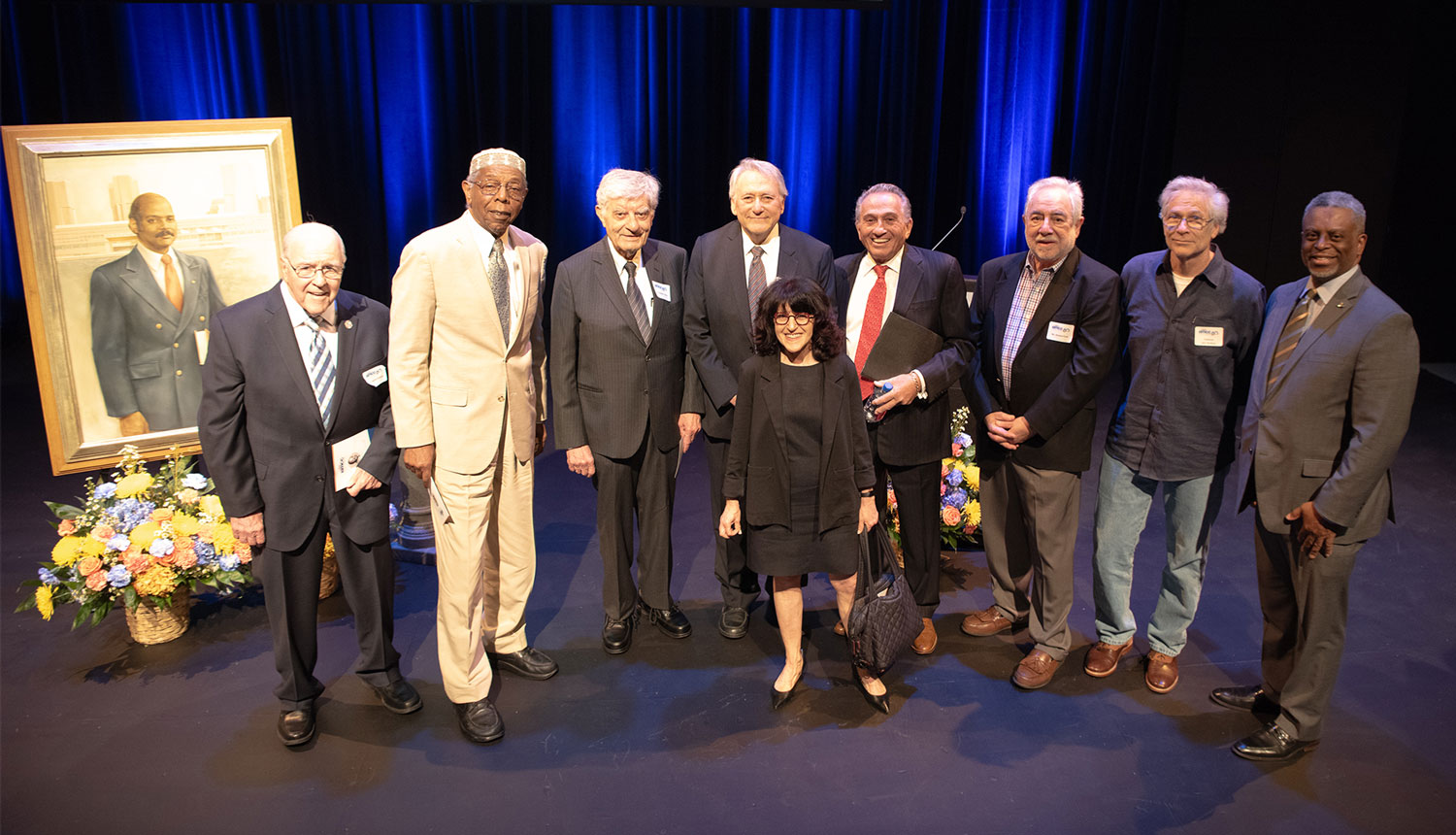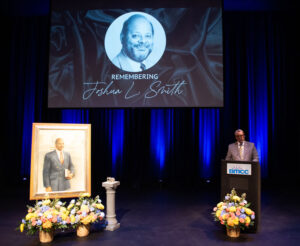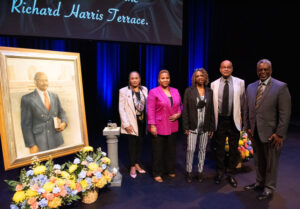
May 8, 2024
Borough of Manhattan Community College (BMCC/CUNY) hosted a remembrance program honoring Dr. Joshua L. Smith, the College’s fourth president, on May 2 in Theatre 2 at 199 Chambers St. Dr. Smith led the college from 1977 until 1985, a period of fundamental transformation for BMCC.
During his welcoming remarks, Dr. Anthony E. Munroe, BMCC President, said Dr. Smith led the College through a period of tremendous growth and transformation.
 “His forward thinking for the future of higher education left an indelible mark on our institution,” said President Munroe. “As we reflect on Dr. Smith’s life and work, let us draw inspiration from his example. Let us work to ensure that BMCC remains a beacon of higher education for all, for generations to come.”
“His forward thinking for the future of higher education left an indelible mark on our institution,” said President Munroe. “As we reflect on Dr. Smith’s life and work, let us draw inspiration from his example. Let us work to ensure that BMCC remains a beacon of higher education for all, for generations to come.”
In addition to current BMCC administrators, faculty and staff, the event was attended by former college officials and colleagues of Dr. Smith as well as family members.
Speakers included Karen Wilson-Stevenson, Interim Vice President, Office of Institutional Advancement, BMCC; Dr. Anthony E. Munroe, President, BMCC; Dr. Erwin Wong, Provost and Vice President, BMCC; former Interim President Dr. Evangelos Gizis, BMCC; Richard Fuchs Esq., former administrator, BMCC; Dr. James Blake, Professor, BMCC and Rev. Keith Smith, nephew of Joshua Smith.
With their vivid recollections, former colleagues opened up a revealing window into a challenging time when Dr. Smith led BMCC’s move from a crowded mixed-use commercial building, located on the gritty edges of 1970’s-era Midtown, to a modern state-of-the-art campus facility that stretches across four continuous blocks of what is now precious lower-Manhattan real estate.
Former Acting President (1985-86) Dr. Evangelos Gizis—who worked closely with Dr. Smith as a Dean as well as holding other administrative duties—recalled that a handful of top city political leaders controlled public project purse-strings when it came to the allocation of funds for large projects such as the 199 Chambers St. project. While all those city leaders agreed that BMCC, with its growing enrollment, needed to have a home, the question was, “Where?”
Some leaders at the now-defunct New York City Board of Estimate, which made the final decision on projects such as this one, felt BMCC could make its home in an existing repurposed building, such as the then- headquarters for insurance firm GHI, said Dr. Gizis. There were a number of hotels and other facilities including former schools that were also being considered, Dr. Gizis recalled.
“But President Smith said there was only one solution, the resumption of construction of the 199 Chambers St. campus, which had been stalled due to the city’s fiscal crisis” said Dr. Gizis.
Countless meetings with city officials transpired, according to Dr. Gizis. Eventually a proposal was accepted by the CUNY chancellor, construction was re-started and mostly completed by December 1983.
“President Smith’s presence and ability to attract attention as he entered the room, his communication skills, his gift to create a sense of trust, and especially what I knew to be his stoic attitude in the face of adversity—all these things were characteristics that helped the college to thrive and eventually enroll 10,000 students,” said Dr. Gizis.
The college was stable; the instruction was excellent and it was located in a beautiful campus near plenty of part and full-time Wall Street jobs, explained Dr. Gizis.
Former administrator Richard Fuchs Esq., recalled being hired by President Smith while BMCC was still at its Midtown location.
“In one of our buildings, rainstorms would cause flooding in the upper classrooms and made them unusable,” said Mr. Fuchs. “We didn’t have auditoriums of our own. We didn’t have a cafeteria. And worst of all, our educational facilities ranked worst in the country and Middle States threatened to take away our accreditation.”
What impressed Mr. Fuchs most about those challenging days, was the lack of any sense of doom or prospect of failure by Dr. Smith’s immediate coterie.
“We were in it to succeed because Josh (Smith) never doubted success,” said Fuchs. “We did not hesitate to follow his remarkable leadership buoyed by his knowledge, creativity and insight. Josh never lost faith in his mission to save BMCC and make it a respectable learning institution and desirable professional environment that it enjoys being today.”
Mr. Fuchs says there were occasions in which he and Dr. Smith met with politicians who were attempting to interfere with their oversight of a state-funded educational program.
“We always came very much prepared with documentation,” said Fuchs. “However, it was Josh’s calm demeanor, persuasive eloquence, and clear ethical resolve that always carried the day.”
In a particularly moving moment during the ceremony, Mr. Fuchs described the exhilaration Dr. Smith felt when they visited the 199 Chambers construction site as the massive steel frame neared completion.
“I remember Josh beaming with pride for all his efforts and those of his staff, well, coming to fruition,” said Fuchs. “A learning facility with more modern features than other schools at that time, and a welcoming center of learning for many disadvantaged adults. Josh understood that most BMCC students came from limited economic and social backgrounds.”
He added that the lack of amenities on the Midtown campus “was no comforting assurance to them that education would be their lifeline. But Josh did not just see an edifice of brick and steel, he saw a building where students could see the new campus as confirmation that through the portals of BMCC, their lives could change for the better.”
BMCC Professor Dr. James Blake, who served as Assistant Dean of Students during Dr. Smith’s tenure, recalled how Dr. Smith listened to student’s concerns about the Midtown facility.
“A group of students decided that they would march from Midtown down to Chambers Street, where the new building’s steel frame was built,” said Professor Blake. “Josh came and spoke to the students. He complimented them on the discipline that they showed, the way they carried themselves and the message that they were able to get to the politicians.”
But Dr. Blake says President Smith was not just interested in seeing the building completed. He wanted students to be successful.
“He wanted to have programs that would actually advance the educational experience and elevate the lives of poor Black and brown students,” said Professor Blake. “And he was committed to that completely.”
Professor Blake said Dr. Smith was so committed to students that he made time for informal meetings on campus with students.
“He would choose a place on campus, and any student who wanted to come in and speak with him, could do it,” said Professor Blake. “He was there to understand what they, the students, were concerned about. He was a mountain climber, he was resilient, he was determined, and he was the type of person to pull others up the mountain with him.”
 Dr. Smith’s nephew, Rev. Keith Smith said he was deeply honored and humbled by the ceremony.
Dr. Smith’s nephew, Rev. Keith Smith said he was deeply honored and humbled by the ceremony.
“Thank you, Dr. Munroe, thank you Borough of Manhattan Community College, for the event you’ve given us today,” said Rev. Smith. “It is a tremendous honor; not only to me, but also to my family.”
Upon leaving BMCC, Dr. Smith served as chancellor of the Community Colleges of California, overseeing 107 colleges and 1.2 million students. He taught at City College (CUNY) and Baruch College (CUNY) before joining the faculty at New York University. As a member of the Board of Overseers of Regent College of the University of the State of New York, he was a founding member of the Board of Trustees of Regents College. Dr. Smith also served in the U.S. Air Force as a pilot in the Strategic Air Command. He earned a bachelor’s degree in history from Boston University and a master’s and doctoral degree from Harvard University.
Dr. Smith was cited by Diverse Issues in Higher Education as one of the most influential figures in higher education in the 20th century.
- Speakers include former colleagues during Dr. Smith’s BMCC tenure
- Before 1983, BMCC was located in a group of mixed-use commercial spaces in Midtown
- Smith always took time to listen to students while President, says Professor James Blake

